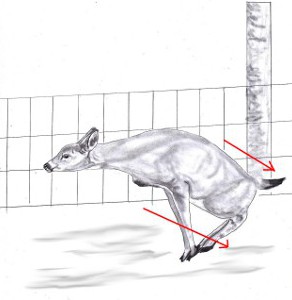See, Stretch, Snap
When it comes to hitting and especially bat speed, there are 3 S’s to follow. See, Stretch, Snap. It’s a sequence of events that a hitter must do to increase bat speed and keep the bat on the plane of the ball as long as possible.Have you ever wondered why some smaller players are able to hit the baseball harder and farther than bigger, stronger players? This is why.
I’ll use my drawings of Feddie Freeman to illustrate how to incorporate See, Stretch, Snap into your swing.
The first part, “See”, is absolutely more important than most hitters know.
SEE:
Freddie Freeman is clearly “seeing” the pitcher with both eyes. I don’t know if Freeman is a left or right eye dominant person, but, it’s crucial to be looking at the pitcher with your dominant eye. If your dominant eye is your rear eye in your stance (right eye for a right-handed hitter, left eye for a left-handed hitter.) you have to make an adjustment in your stance so that you are able to see the pitcher with that dominant eye. This can involve opening your entire stance toward the pitcher, or just try opening your upper torso toward the pitcher. If you are not seeing the pitch with your dominant eye, you, of course will be seeing it with your non-dominant eye. Your non-dominant eye will track the pitch until it gets to where you can see it with your dominant eye. When the flight of the pitch crosses from one eye to the other, it will tend to “jump”. Not much, but enough for you to slightly “miss” the pitch. Stretch: Here's where the Stretch comes into play. As Freeman strides with his front foot, his hips and upper body are coiling in the opposite direction. The coil with the top hand isn’t so much a “push” back toward the catcher. It’s more of a “pull back” toward the dugout behind him. Like he’s getting ready to throw a punch with his top hand. Now his muscles and Myo-Fascial tissue are stretched in opposite directions. Freeman launches his bat. The muscles and tissue that were stretched are now snapped in the same direction. Like snapping a rubber band. This is where bat speed is created. This violent snap forward is stopped by his stiff, front leg that acts like a brake. This causes even more bat speed. Even his jersey is expanding forward. (Blue Arrow). If you were driving a car 75 miles per hour and suddenly slammed on the brakes, everything in the car, including you, would be dramatically propelled forward. This “snap” is the same thing. Notice that as Freeman whips his bat through the strike zone, that his front shoulder is NOT opening toward the dugout. It’s going up and back. Coaches constantly scream at hitters to “keep their shoulder in”. Whether they know it or not, this is what it means to keep your shoulder in. I’ve heard many times on baseball broadcasts, when a smaller hitter crushes one, the broadcasters always say the same thing. “He’s soooo strong.” Actually it’s because their mechanics allow them to incorporate this “Stretch and Snap” into their swing. Hitters spend hours lifting weights to build strength. But if they are not stretching and snapping their myo-fascial tissue, the weights won’t help much. Stretch and Snap In Nature: I’ve spent a good deal of my life in the outdoors. Hunting, hiking, camping. I’ve seen whitetail deer leap high over fences from a stand still and always wondered how they could do it. Deer have thin, spindly legs, but they have large body muscles. And, just like us, they have myo-fascial tissue. Take a look at the following sequence of illustrations and we’ll see how they do it. For this deer to leap this fence, she first has to get into her “load”. Just like a hitter. Her weight gets back into her rear legs. As she begins her leap,the muscles and myo-fascial tissue of her upper and lower body are pulling in opposite directions . Just like in the rubber band example. Her rear legs are still “loaded”. This causes a great amount of stretch in her body. Now the “snap”! Her rear leg muscles have snapped forward in the same direction of her front leg muscles. Everything is going in the same direction now. The Stretch and Snap has propelled her over the fence with room to spare. Practice: I suggest you practice the Freddie Freeman sequence. Start adding this to your mechanics slowly at first. When you get to this point, hold it for a few seconds. Feel that stretch. Remember, you’re not pushing your hands back toward the catcher. It’s more of a “pull back” with your top hand.










